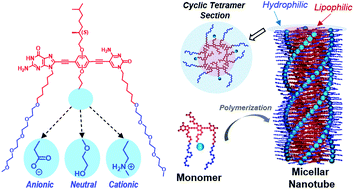Exploring the tubular self-assembly landscape of dinucleobase amphiphiles in water†
Abstract
The design and production of the next generations of synthetic aqueous self-assembled systems able to mimic some biological features will require increasingly sophisticated monomer constituents that make use of additional interactions to hydrophibic effects to attain enhanced structural and functional complexity. Here, we broadly investigate the aqueous self-assembly of dinucleobase amphiphilic monomers into helical nanotubes under a wide range of different conditions of temperature, concentration, solvent composition and pH. Such monomers comprise an amphiphilic π-conjugated central block, endowed with a lipophilic chiral tail and a hydrophilic group that can be made anionic (carboxylate), neutral (glycol) or cationic (ammonium), disubstituted with complementary guanine and cytosine nucleobases at each termini. These molecules self-assemble into amphiphilic nanotubes in water but, when subjected to diverse (drastic) changes in the experimental conditions, undergo either disassembly into monomers, chiral reorganization, or a morphological restructuration into globular objects due to dehydration of the peripheral hydrophilic groups.

- This article is part of the themed collection: Macrocycle-based Supramolecular Elements


 Please wait while we load your content...
Please wait while we load your content...